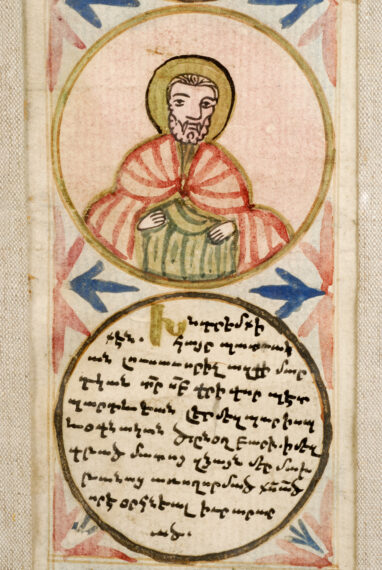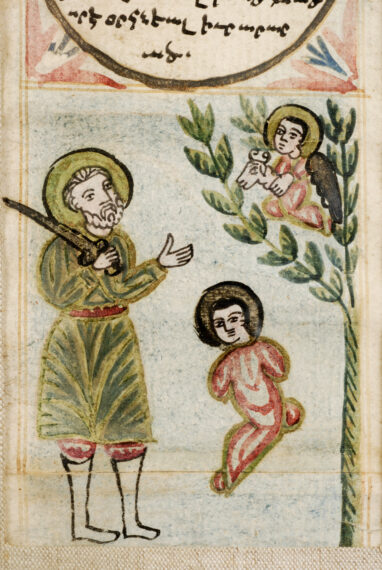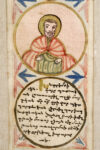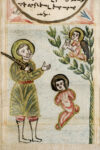PRAYER SCROLL
Manuscript on paper, 17th-18th century. Fragment
PRAYER SCROLL
Manuscript on paper, 17th-18th century. Fragment
Notrgir writing
Provenance : former Nourhan Fringhian collection.
Bibliography : Fringhian museum catalog, 1989.
Paris, Armenian Museum of France, Nourhan Fringhian Foundation.
The prayer scrolls (hemail) are characteristic of late book production. Although the oldest preserved example dates from 1428, it is more difficult to place the appearance of these phylacteries. A scroll dating from before 1374, inscribed in Greek on the obverse and in Arabic on the reverse, now divided between the Pierpont Morgan Library in New York and the University Library of Chicago, testifies to the use of magical phylacteries in the Eastern Mediterranean in the late Middle Ages. The interest in magical texts, characteristic of a secular audience, is also manifested in books: the first printed in Venice contains prayers against spells and diseases. Another manuscript, from the seventeenth or eighteenth century, contains horoscopes, the names of seventy-two demons, and medical recipes, not to mention a large number of demon figures.
The widespread use of magic amulets in the Islamic world certainly stimulated the spread of similar Armenian forms.
Armenian magic scrolls are usually written on paper and abundantly provided with images that alternate with the text and sometimes replace it, barely leaving room for a short prayer. Printed scrolls appeared in Istanbul in the 18th century at the same time as the printing press. As for the content, it is made up of passages from the scriptures and canonical prayers, associated with magic formulas and invocations specific to amulets. These are often texts reproduced from memory, in a mixture of classical and vernacular languages, sometimes using Turkish, Kurdish or Arabic transcribed in Armenian characters.
Intended for private use, the phylacteries have no real colophon and end with a simple formula calling for the protection of God over his duly named servant.
The fragment presented here contains a series of invocations preceded by the figures of the saints to whom they are addressed: the Mother of God carrying the Child, St. Stephen holding the censer, St. John the Baptist and St. Gregory the Illuminator. Below, the sacrifice of Abraham is cut out of the passage from Genesis that systematically appears in the magic scrolls. The fragment is characterized by its great simplicity and the linear treatment of the draperies and faces, which is expected in this type of production.
Ioanna Rapti
cf. Armenia Sacra, p. 32, Editions Somogy/Musée du Louvre 2007.”
In Armenia, the art of books is linked to the invention of writing. Until the 5th century AD, the inhabitants of the Armenian plateau had successively used the cuneiform script (Urartu), and later, with the various conquests, Aramaic (the Persian period), Greek (the Hellenistic and Parthian period) and Latin characters (under Roman domination).
Driven by the need to have a specific writing adapted to the language, around the year 405, an Armenian monk, Mesrop Mashtots, invented an alphabet composed of thirty-six letters or graphemes corresponding to the thirty-six phonemes of the oral language used in the 5th century.
The most widely distributed and recognized book in this Christian nation was the first to be transcribed: The Bible.
This allowed the many copyists in monasteries to learn the alphabet, and they acted as network for disseminating Christianity, and thereby strengthening Armenian identity. This transmission of a culture and a religion made it possible for the identity of a civilisation remain intact despite the vicissitudes of history.
The texts were at first, for the most part, religious, biblical (The Bible—Gospels) or liturgical (Lectionaries—Hymnaries—Psalms—Homiliaries, etc.).
From the end of the 9th century, there was an increase in the amount of manuscript works produced, propagating the faith of a people through this fundamental medium which is writing: it is the union of the written word and religion that allowed this people to survive, despite the lack of an organised state.
To embellish the written word, painters assisted the scribes, and it is in books that we find the best expression of Armenian pictorial art.
The Armenian book was printed in 1511, but manuscripts had such a predominant role that, unlike other countries, book printing in Armenia did not fully develop until the 18th century and it was not until the 19th century that it reached the stage where it could actually replace the work performed by hand.





